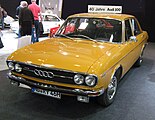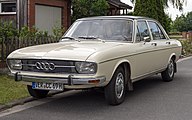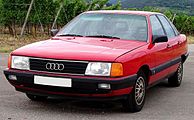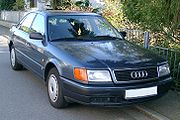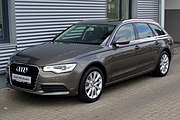Audi 100 / A6
The Audi 100 ( A6 since 1994 ) refers to a series of the upper middle class from Audi , internally also called the "C-series".
The Audi 100 appeared in March 1968 and was produced in four generations by July 1994. Since the type specifications were restructured in August 1994, the vehicle has been called A6. In contrast to the Audi 80 / A4 , where the renaming coincided with the model change, the first A6 was just a revised version of the last Audi 100.
The A6 is now available as a four-door notchback sedan and a five-door station wagon ( Avant ). Earlier models were also available as two-door sedans (C1 and C2), coupé (C1) or hatchbacks (C2). The sport variant is called S6 . An even more powerful version is represented under the name RS6 .
100 (1968-1994)
100 C1 (1968–1976)
The first Audi 100 generation, the C1, which appeared in spring 1968, laid the foundation for the current success of the Audi brand. Despite its overall still quite conservative concept, the front-wheel drive, which was still rare in this car class at the time, and the pleasing shape of the spacious body ensured good sales success, because a total of 827,474 units of the first Audi 100 generation were built, including 30,687 units of the coupé available from summer 1970 . A two-door sedan was available from dealers as early as autumn 1969.
The reliable but tough engines were all lengthways inline four-cylinder with a side camshaft and carburetor. They were based on the “medium pressure engine ” of the Audi F103, originally taken over by Mercedes, and were offered in the output levels 80 hp to 115 hp (59 kW to 85 kW). However, the more modern OHC engine with 1600 cc and 85 PS (63 kW) from the new Audi 80 was available as the basic engine from 1974.
As with the F103, the four-speed gearbox was offered with either a steering wheel or center shift. A three-stage automatic was also available from 1970. Power steering - an advantage because of the high load on the front axle - was only available from 1971.
The C1 was built as a two- and four-door notchback sedan and a two-door coupé until July 1976.
100 C2 (1976-1982)
The Audi 100 C2 was presented in August 1976 with a new body and new OHC engines. In particular, the five-cylinder in-line gasoline engine offered from 1977 onwards, which was offered as a carburettor version (85 kW / 115 PS) and an injection version (100 kW / 136 PS). With its good running smoothness, it was closer to the six-cylinder than the four-cylinder. From autumn 1978 a diesel engine with five cylinders and 51 kW (70 hp) was also offered.
The C2 was optionally available as a two- or four-door sedan, which was supplemented for the first time in September 1977 by a hatchback version called the Avant with a large tailgate and variable (foldable) rear seat bench.
A luxury version known as the “CD 5E” offered a wide range of equipment, which was upgraded in the Audi 200 5T from 1979 with a turbo-charged five-cylinder engine with 125 kW (170 hp). A five-speed transmission was also available for the first time in the C2. This model was also exported to the USA, where it was called the Audi 5000 .
100 C3 (1982-1991)
The Audi 100 C3 presented in August 1982 set a world record in the field of aerodynamics . The drag coefficient (c W ) of the spacious body of 0.30 made the trade press sit up and take notice, but this model posed new problems such as "interior heating" due to the steeply inclined windows.
In addition to the sedan, which was only built in the four-door version, an Avant was again available as a station wagon from mid-1983. From mid-1983 there was also the luxurious offshoot of this generation, the Audi 200 , which was only launched on the market as an Avant in the summer of 1984. In the United States, the models were available as the Audi 5000 .
As a special feature in large-scale production, the body of the C3 was fully galvanized. The technology was essentially the same as in the predecessor, with the exception of some changes. The five-cylinder diesel was also offered as a turbo version from mid-1983 and as a direct-injection ("TDI") version for the first time from the beginning of 1990. From autumn 1984 (model year 1985) the 100 and 200 Turbo were available as quattro with all-wheel drive.
100 C4 (1990-1994)
The last Audi 100 generation followed at the end of 1990 (internally called the C4), which was launched on the market without a trade fair premiere, as the then reigning Volkswagen Group boss Carl H. Hahn made a presentation on the grounds that a car could only be presented when series production started is refused. After a revision in the summer of 1994, it was named A6. From autumn 1991 an Avant was again in the program, which was now a pure station wagon and not a mixture of hatchback and station wagon.
The body was again completely new, although at first glance it looked quite similar to the C3. The chassis has been slightly revised. In addition to the well-known four- and five-cylinder in-line engines, there was a new V6 with initially 2.8 liters displacement and 128 kW (174 hp). All gasoline engines were equipped with a regulated catalytic converter.
In mid-1991, the S4 appeared as the new top-of-the-range model based on the already known turbo five-cylinder, but with two overhead camshafts and four valves per cylinder. The engine developed 169 kW (230 hp). The S4 was delivered exclusively with permanent all-wheel drive.
In 1992 the S4 got the 206 kW (280 hp) V8 engine from the Audi V8 and, optionally, a six-speed manual transmission. All C4s were delivered with an airbag as standard from 1993. On the occasion of the revision and renaming in July 1994 to the A6, the last five-cylinder gasoline engines were removed from the range.
A6 (since 1994)
The series was renamed A6 or S6 to the new model designation strategy “Audi A x” in the summer of 1994. The logic introduced with the Audi F103 was to name the Audi models according to their output in hp (Audi 60 to Audi 90) already not been maintained with the C1 . The first Audi A6 to be renamed was a “face-lifted” Audi 100 C4, which was built as the Audi A6 C4 until spring 1997.
The second generation of the Audi A6 C5 was built from April 1997 to August 2005.
For the introduction of the renewed C6 series , the sedan received the European Car No. 1 award at the Geneva Motor Show in spring 2004 . In the readers' poll The Best Cars 2005 by the trade magazine Auto Motor und Sport , the A6 was the winner in its class and was also awarded the Yellow Angel 2005 award by ADAC .
In 2005, the A6 succeeded in ending Mercedes' more than 30 years of dominance in the upper middle class on the German market. The A6 was just ahead of the E-Class and the BMW 5 Series in first place. In 2006, it defended its lead and expanded it further. In the following years, the E-Class again took first place. In Europe, too, the A6 was the best-selling model in the upper mid-range in 2005.
The fourth generation, the Audi A6 C7 , came onto the market in April 2011 . It is available with a choice of three petrol and four diesel engines. The Avant estate version has been available since September 2011. The sports variant S6 was presented at the IAA 2011 , the more powerful Audi RS6 followed in summer 2013.
Audi will present the A6 C8 at the 88th Geneva Motor Show in March 2018 . The market launch took place in June 2018. The Avant and the sport versions S6 and RS6 are to follow later.
Audi A6 C4 (1994–1997)
Audi A6 C5 (1997-2005)
Audi A6 C6 (2004-2011)
Audi A6 C7 (2011-2018)
Audi A6 C8
(since 2018)
Private customers make up only a small part of the A6 new car buyers. In 2008, 86.7% of all Audi A6s sold in Germany were registered commercially.
literature
- Michael Modrow, Andreas Bauditz: Audi 100. Heel Verlag, 2009, ISBN 3-89880-899-8 .
Web links
- Link catalog on the topic of Audi 80, 90, 100 and 200 models at curlie.org (formerly DMOZ )
- Official website of the A6
- Technical data A6
- Link catalog on the topic of Audi A models at curlie.org (formerly DMOZ )
- Autobild used car test for the Audi A6 C5 (1997-2004) ( Memento from March 2, 2005 in the Internet Archive )
Individual evidence
- ↑ Heinz Blüthmann: A good stopgap solution . The fight for the top job ended surprisingly: Carl H. Hahn continues. In: The time . No. 45/1990 , November 19, 1990 ( Die Zeit online [accessed on July 21, 2018]): “For example, the Audi boss was not allowed to show his new model of the Audi 100 mid-range car to the public for the first time at the Paris Salon in autumn because VW Boss Hahn was against it. His strange argument: 'You can only present a car when the series has started.' "
- ^ New registrations in January 2008: More small cars, fewer private buyers. Retrieved August 5, 2013 .
